Pneumonia
| Pneumonia | |
|---|---|
| Classification and external resources | |
 | |
| ICD-10 | J12.,J13.,J14.,J15.,J16.,J17.,J18.,P23. |
| ICD-9 | 480-486,770.0 |
| DiseasesDB | 10166 |
| MedlinePlus | 000145 |
| eMedicine | topic list |
| MeSH | D011014 |
Pneumoniais adiseaseof thelungsand the lowerrespiratory system.The lung contains many small bulbs, or sacs, calledalveoli.These help to take outoxygenfrom theair.In the case of pneumonia, these bulbs becomeinflamed.The lungs fill up with a fluid which is calledpus,and can no longer absorb as much oxygen as before. This is calledempyemaoremphysema(emp-ee-eema). This makes it hard for the person with pneumonia to breathe. They may feel out of breath, or like they are drowning. They may also feel pain when they breathe. Sometimes people die (30% of patienents under 65) of pneumonia, even when they go to a hospital and take medicine (21% in-hospitalmortalityrate all patients ages).
Background
[change|change source]Pneumonia is aninfectiousdisease that can be caused bybacteria,viruses,fungiorparasites.It may be spread outside of hospitals (community-aquired pneumonia) and can both cause or be caused by other related disease present, including CA-MRSA(community acquired flu) or be hospital acquired (called nosocomical) if it happens 48 hours or less after visiting hospital. It can also be caused by chemical or physical damage done to the lungs. Other illnesses, likealcoholabuse orlung cancer,can also result in pneumonia.
People with pneumonia usually have difficultybreathing.They may alsocough,or have pain in thechestarea. The treatment of pneumonia depends on how the illness was caused. If it was caused by bacteria or fungi,antibioticscan be used to treat it.
People of all ages can have pneumonia. The disease is dangerous. Many people die from pneumonia, especially old people, or people or babies with a weakimmune system.
According to some research in 2010, in some parts of the world where people are very poor likeIndia,Nigeria,Pakistan,andGuineapneumonia was the cause of death for more children under the age of five than any other disease. Statistically, however, for every 2,000 children in the developing world who die of pneumonia, only one child in the developed world dies from the disease. This is because of differences in health care.
Treatment
[change|change source]Pneumonia can be treated with medications that target the specific source of the infection. This might be an antibiotic, anantiviral,or anantifungalmedication taken by mouth as a tablet orintravenously.Other therapies support a patient by providing comfort. These may include oxygen given by nose or mouth, inhalers to breathe in and expand the lungs, or steroids to decrease swelling.
Other types of pneumonia
[change|change source]
- Severe acute respiratory syndrome(SARS)
- SARS is a highlycontagiousand deadly type of pneumonia which first occurred in2002after initialoutbreaksinChina.SARS is caused by theSARS coronavirus,apathogen(disease-causing organism) that was not known until then. New cases of SARS have not been seen since June 2003.
- Bronchiolitis obliterans organizing pneumonia(BOOP)
- BOOP is caused by inflammation (swelling or irritation) of the small airways of the lungs. It is also known ascryptogenic organizing pneumonitis(COP).
- Eosinophilic pneumonia
- Eosinophilic pneumonia isinvasionof the lung byeosinophils.Eosinophils are a particular kind ofwhite blood cells.Eosinophilic pneumonia often occurs in response to infection with aparasiteor after exposure to certain types of environmental factors.
- Chemical pneumonia
- Chemical pneumonia (usually calledchemical pneumonitis) is caused by chemicaltoxinssuch aspesticides,which may enter the body byinhalation(breathing in) or byskincontact. When the toxic (poisonous or harmful) substance is an oil, the pneumonia may be calledlipoid pneumonia.
- Aspiration pneumonia
- Aspiration pneumonia (or aspiration pneumonitis) is caused by accidentally inhaling oral (mouth) or gastric (stomach) contents into the lungs, either whileeating,or after reflux orvomiting,and causing damage to the lungs. The lung inflammation from these materials is not an infection but it can eventually cause one, since the material taken into the lungs may contain bacteria. Aspiration is a common cause of death among hospital andnursing homepatients, since they sometimes cannot cough hard enough to protect their airways.
